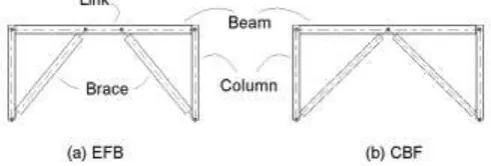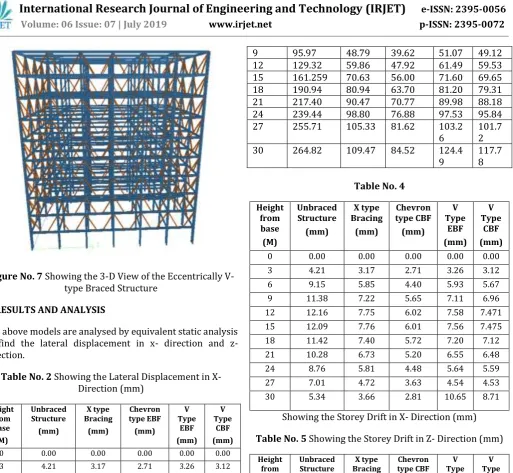© 2019, IRJET | Impact Factor value: 7.211 | ISO 9001:2008 Certified Journal
| Page 1662
SEISMIC ANALYSIS OF ECCENTRICALLY AND CONCENTRICALLY STEEL
BRACED STEEL STRUCTURES
Vipul Neeraj Khosla
1, Dr. Atul. B. Pujari
21
Post Graduate Student Department of Civil Engineering, KJ College of Engineering & Management Research,
Pune-28
2
Associate Professor Department of Civil Engineering, KJ College of Engineering & Management Research, Pune-28
---***---ABSTRACT - Steel is an important construction material and
plays a very significant role in the developing societies. Construction is an industry where steel is used to a greater extent, exceeding use of 50% of world’s steel. Steel also offers good architectural view and it gives more freedom of design for structural engineers. Earthquake can be defined as the shaking of the surface of the Earth, resulting from the sudden release of energy in the Earth's lithosphere that creates seismic waves.
When the structure is experiencing seismic forces it has been observed that the bracing system resist the forces effectively. The analysis in the paper shows that the bracing system when applied in the steel structures helps in dissipating the seismic energies more effectively than the unbraced structures. The design of steel structures which falls under seismic active zones shall be deigned in such a way that they effectively soak the horizontal forces acting on the structures caused due seismic activities. The performance of the steel structures can be increased by the application of the bracing systems as it increases the lateral stiffness and capacity of the structures. In this study various eccentrically and concentrically steel braced steel structures will be analyzed for seismic analysis to find the stability of the structures while seismic vibrations.
Keywords: Steel, Structures, Earthquake, Bracing System, Seismic Excitation, Horizontal Loads.
1. INTRODUCTION
Earthquake is an oscillation which is generated by forces beneath the lithosphere, moving through the asthenosphere. It can be stated as the vibration which takes place because of energy released in asthenosphere. The release of the energy is result of the immediate disruption or the demonstrative outburst of portion of the crust, or even due to the human interventions caused by explosions. This problem has been a significant subject of consideration for investigators. Eventually many researchers and scholars suggested the use of bracing system for the effective resistance of the seismic loads.
During the seismic activities the seismic energy generated is found to be effectively soaked up by the bracing system. The steel structures which are in the earthquake prone areas should be designed such that they can effectively resist the horizontal loads. The designs of structures require a good
amount of balance between strength, ability, and energy dissipation. To satisfy these requirements of the steel structures different types of structural systems like the OMRF (Ordinary Moment Resisting Frames), ordinary Concentric Braced Frames and Eccentric Braced Frames are opted in these areas.
Figure (a) Showing Eccentrically Braced Frame and Figure (b) Concentrically Braced Frame
1.1 Objectives
1) To find effective bracing systems to resist the seismic loads.
2) To study the behaviour of unbraced structures, eccentrically braced structures and concentrically braced structures along with there comparison.
3) To evaluate the inter-story drift and base shear various frames by performing Equivalent Static Analysis in STAAD.Pro V8i 2016.
2. LITERATURE REVIEW:
Federico M. Mazzolani, et al.,2009, Journal of Civil Engineering and Management, in their paper they mentioned that among the possible systems to retrofit an existing structure, bracing systems appear to be simple and effective, especially when storey drifts need to be limited.
[image:1.595.311.557.319.402.2]© 2019, IRJET | Impact Factor value: 7.211 | ISO 9001:2008 Certified Journal
| Page 1663
the lateral storey displacements of the building wheninverted-V bracing system is used.
Zasiah Tafheem, et al., 2013, IJCSE, in their paper they mentioned that the concept of using steel bracing is one of the advantageous concepts which can be used to strengthen or retrofit the existing structures. The author concluded that Concentric X Bracing system is more resistant to storey displacements as compared to the Eccentric V Bracing Systems. While considering steel buildings design the Concentric X Bracing has been found to be most effective for lateral stiffness. It is found that in presence of bracing system the inter-storey drift is highly reduced.
Matha Prasad Adari, 2018, IJET, in his paper reported that the Braced steel frame have more base shear than unbraced frames. It was found that the base shear is experienced much more in Cross bracing as compared to diagonal bracing. It is found that the lateral displacements in floors are reduced by the application of bracing systems. The diagonal bracings shows more lateral displacement than Cross bracing. Peak storey shear is higher in cross braced structures.
3. METHODOLOGY
1. An unbraced frame structure is selected with the geometrical parameters given.
The structure is taken in Seismic Zone IV with the zone value 0.24.
2. The base shear and lateral displacement of the structure is to been calculated by performing the equivalent static analysis on STAAD.Pro V8i 2016. 3. The structure is then compared with various braced
structure i.e. X- Braced Structure, Chevron Type Eccentrically Braced Structure, V- Type Concentrically Braced Structure and V- Type Eccentrically Braced Structure and a suitable structure with least lateral displacement is recognized and considered comparatively more safe.
4. MODELLING IN STAAD.PRO
Table No. 1 Showing the Geometric Parameters of the Building
No. of stories G+10
Type of building Commercial
Height of Building 30m
Dimension of Building 20m X 30m Young’s modulus 2.05x105 N/mm2
Density of Steel 76.8 kN/m3
Seismic Zone IV (0.24)
Type of Soil Medium Soil
Size of Column ISMB 600
Size of Beam ISMB 300
[image:2.595.39.551.31.800.2]Size of Bracing 150 mm x 150 mm x 15 mm
Figure No. 1
[image:2.595.334.559.55.453.2]© 2019, IRJET | Impact Factor value: 7.211 | ISO 9001:2008 Certified Journal
| Page 1664
Figure No.1 Showing the Plan of the Structure and FigureNo. 2 Showing the Elevation of the Structure
Figure No. 3
Figure No. 4
Figure No. 3 Showing the 3-D View of the Unbraced Structure and Figure No. 4 Showing the 3-D View of the X-Type Braced Structure
Figure No. 5
Figure No. 6
© 2019, IRJET | Impact Factor value: 7.211 | ISO 9001:2008 Certified Journal
| Page 1665
Figure No. 7 Showing the 3-D View of the EccentricallyV-type Braced Structure
5. RESULTS AND ANALYSIS
The above models are analysed by equivalent static analysis to find the lateral displacement in x- direction and z- direction.
Table No. 2 Showing the Lateral Displacement in X- Direction (mm) Height from base (M) Unbraced Structure (mm) X type Bracing (mm) Chevron type EBF (mm) V Type EBF (mm) V Type CBF (mm)
0 0.00 0.00 0.00 0.00 0.00
3 4.21 3.17 2.71 3.26 3.12
6 13.33 9.03 7.11 9.19 8.80
9 24.75 16.26 12.77 16.30 15.77
12 36.92 24.01 18.80 23.88 23.24
15 49.01 31.78 24.81 31.45 30.71
18 60.44 39.186 30.53 38.66 37.84
21 70.72 45.92 35.74 45.21 44.33
24 79.49 51.736 40.22 50.85 49.93
27 86.50 56.457 43.86 55.40 54.46
30 91.85 60.12 46.67 66.06 63.17
Table No. 3 Showing the Lateral Displacement in Z- Direction (mm) Heigh t from base (M) Unbrace d Structure (mm)
X type Bracin g (mm)
Chevro n type CBF (mm) V Type EBF (mm) V Type CBF (mm)
0 0.00 0.00 0.00 0.00 0.00
3 27.67 25.64 20.57 29.31 27.82
6 61.854 37.45 31.26 40.49 38.54
9 95.97 48.79 39.62 51.07 49.12
12 129.32 59.86 47.92 61.49 59.53 15 161.259 70.63 56.00 71.60 69.65 18 190.94 80.94 63.70 81.20 79.31 21 217.40 90.47 70.77 89.98 88.18 24 239.44 98.80 76.88 97.53 95.84 27 255.71 105.33 81.62 103.2
6 101.72 30 264.82 109.47 84.52 124.4
9 117.78
Table No. 4
Height from base (M) Unbraced Structure (mm) X type Bracing (mm) Chevron type CBF (mm) V Type EBF (mm) V Type CBF (mm)
0 0.00 0.00 0.00 0.00 0.00
3 4.21 3.17 2.71 3.26 3.12
6 9.15 5.85 4.40 5.93 5.67
9 11.38 7.22 5.65 7.11 6.96
12 12.16 7.75 6.02 7.58 7.471
15 12.09 7.76 6.01 7.56 7.475
18 11.42 7.40 5.72 7.20 7.12
21 10.28 6.73 5.20 6.55 6.48
24 8.76 5.81 4.48 5.64 5.59
27 7.01 4.72 3.63 4.54 4.53
30 5.34 3.66 2.81 10.65 8.71
[image:4.595.66.264.74.302.2]Showing the Storey Drift in X- Direction (mm)
Table No. 5 Showing the Storey Drift in Z- Direction (mm)
Height from base (M) Unbraced Structure (mm) X type Bracing (mm) Chevron type CBF (mm) V Type EBF (mm) V Type CBF (mm)
0 0.00 0.00 0.00 0.00 0.00
3 27.67 25.64 20.57 29.31 27.8
6 34.18 11.80 10.68 11.17 10.71
9 34.12 11.34 8.36 10.58 10.58
12 33.35 11.07 8.30 10.41 10.40
15 31.93 10.76 8.08 10.13 10.12
18 29.69 10.30 7.69 9.60 9.65
21 26.45 9.53 7.06 8.78 8.87
24 22.04 8.33 6.11 7.54 7.66
27 16.21 6.52 4.73 5.73 5.87
[image:4.595.46.563.422.794.2]© 2019, IRJET | Impact Factor value: 7.211 | ISO 9001:2008 Certified Journal
| Page 1666
6. CONCLUSIONSAfter conducting the analysis on the structure with unbraced and various types of bracing systems, we can conclude that the displacement of the structure decreases after applying the bracing systems when compared to the unbraced structure.
The lateral displacement and the storey drift is comparatively less in the Chevron type Eccentrically Braced Frame. From which we can conclude that the application of the steel bracings can reduce the effect of the seismic vibrations on the structure. If proper bracings are applied to the structures the losses which occurs due to the earthquakes can be reduced.
7. REFERENCES
1. Federico M. Mazzolani, Gaetano Della Corte, Mario D’Aniello(2009) “Experimental Analysis of Steel
Dissipative Bracing Systems for Seismic Upgrading” Journal of Civil Engineering and Management.
2. Madhusudan G. Kalibhat, Kiran Kamath Prasad S. K, Ramya R. Pai “Seismic Performance of Concentric Braced Steel Frames From Pushover Analysis” IOSR Journal of Mechanical and Civil Engineering (IOSR-JMCE).
3. Zasiah Tafheem and Shovona Khusru(2013) “Structural behavior of steel building with concentric and eccentric bracing” International Journal of Civil and Structural Engineering Volume 4.
4. Matha Prasad Adari(Mar-Apr 2018) “Seismic
Analysis of Steel Frames Subjected to Braced Connections” International Journal of Engineering and Techniques - Volume 4 Issue 2.
5. Waghmare A.I, Deshmukh M.M, Pawar M.M (5 May
2017) “Performance of High Rise Steel Frame with Different Type of Bracing and Without Bracing” , International Journal of Engineering Trends and Technology (IJETT) – Volume 47.
6. Sreeshma. K. K (September 2016) “Seismic
Performance Assessment of Different Types of Eccentric Braced Systems”, IJIRST –International Journal for Innovative Research in Science & Technology, Volume 3 ,Issue 04.
7. Anitha M and Divya K.K (Sep-2015) “Study on
Seismic Behaviour of Knee Braced Steel Frames” International Research Journal of Engineering and Technology (IRJET), Volume: 02.
8. Mrutyunjay.S.Hasarani and M.B.Iswhwaragol(July
2016) “Seismic performance evaluation of high-rise steel frame with eccentric K- and V-bracings” International Research Journal of Engineering and Technology (IRJET), Volume: 03 Issue: 07.
9. Sachin Dhiman, Mohammed Nauman, Nazrul Islam
(January 2015) “Behaviour of Multistory Steel Structure with Different Types of Bracing Systems (A Software Approach)” International Refereed Journal of Engineering and Science (IRJES), Volume 4, Issue 1.
10. Rafael Sabelli, Charles W. Roeder, Jerome F. Hajjar
“Seismic Design of Steel Special Concentrically Braced Frame Systems”
11. Mohd Mubeen, Khalid Nayaz Khan, Mohammed
© 2019, IRJET | Impact Factor value: 7.211 | ISO 9001:2008 Certified Journal
| Page 1667
Technology in Engineering and Science VolumeNo.03, Issue No. 06.
12. Indian Standard Code, Criteria For Earthquake
Resistant Design of Structures (IS 1893-Part 1-2016).
13. Indian Standard Code, Design Loads (Other Than
Earthquake) For Building and Structures (IS 875-Part 32015).
14. Indian Standard Code, Design Loads (Other Than


